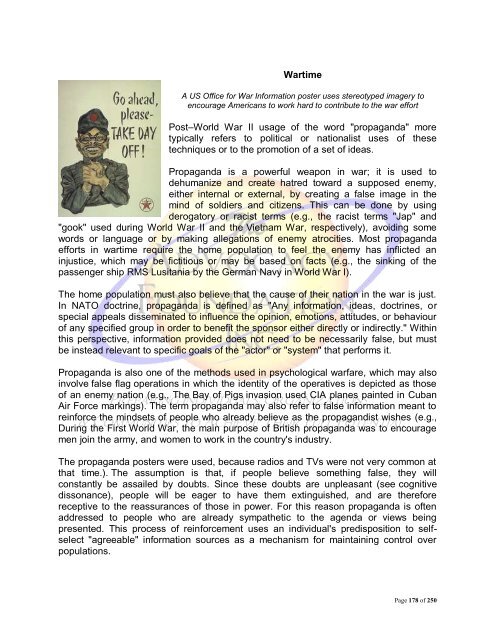Institutional Racism
Institutional Racism
Institutional Racism
You also want an ePaper? Increase the reach of your titles
YUMPU automatically turns print PDFs into web optimized ePapers that Google loves.
Wartime<br />
A US Office for War Information poster uses stereotyped imagery to<br />
encourage Americans to work hard to contribute to the war effort<br />
Post–World War II usage of the word "propaganda" more<br />
typically refers to political or nationalist uses of these<br />
techniques or to the promotion of a set of ideas.<br />
Propaganda is a powerful weapon in war; it is used to<br />
dehumanize and create hatred toward a supposed enemy,<br />
either internal or external, by creating a false image in the<br />
mind of soldiers and citizens. This can be done by using<br />
derogatory or racist terms (e.g., the racist terms "Jap" and<br />
"gook" used during World War II and the Vietnam War, respectively), avoiding some<br />
words or language or by making allegations of enemy atrocities. Most propaganda<br />
efforts in wartime require the home population to feel the enemy has inflicted an<br />
injustice, which may be fictitious or may be based on facts (e.g., the sinking of the<br />
passenger ship RMS Lusitania by the German Navy in World War I).<br />
The home population must also believe that the cause of their nation in the war is just.<br />
In NATO doctrine, propaganda is defined as "Any information, ideas, doctrines, or<br />
special appeals disseminated to influence the opinion, emotions, attitudes, or behaviour<br />
of any specified group in order to benefit the sponsor either directly or indirectly." Within<br />
this perspective, information provided does not need to be necessarily false, but must<br />
be instead relevant to specific goals of the "actor" or "system" that performs it.<br />
Propaganda is also one of the methods used in psychological warfare, which may also<br />
involve false flag operations in which the identity of the operatives is depicted as those<br />
of an enemy nation (e.g., The Bay of Pigs invasion used CIA planes painted in Cuban<br />
Air Force markings). The term propaganda may also refer to false information meant to<br />
reinforce the mindsets of people who already believe as the propagandist wishes (e.g.,<br />
During the First World War, the main purpose of British propaganda was to encourage<br />
men join the army, and women to work in the country's industry.<br />
The propaganda posters were used, because radios and TVs were not very common at<br />
that time.). The assumption is that, if people believe something false, they will<br />
constantly be assailed by doubts. Since these doubts are unpleasant (see cognitive<br />
dissonance), people will be eager to have them extinguished, and are therefore<br />
receptive to the reassurances of those in power. For this reason propaganda is often<br />
addressed to people who are already sympathetic to the agenda or views being<br />
presented. This process of reinforcement uses an individual's predisposition to selfselect<br />
"agreeable" information sources as a mechanism for maintaining control over<br />
populations.<br />
Page 178 of 250

















